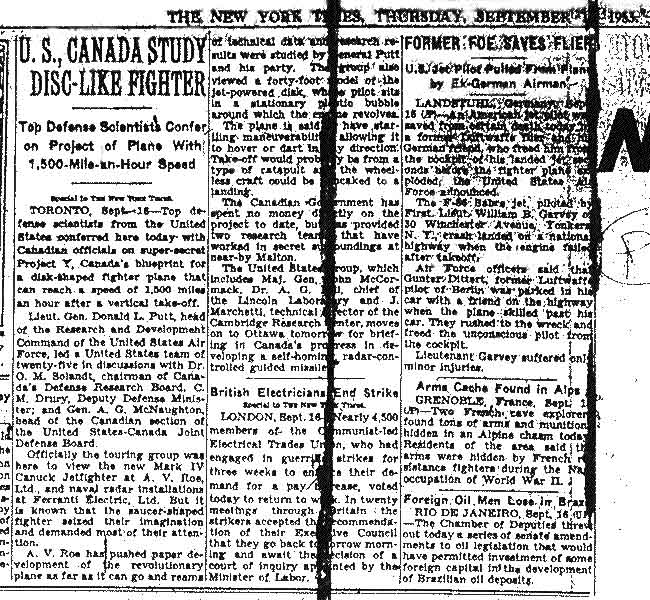
Top Defense Scientists Confer on Project of Plane With 1,500-Mile-an-Hour Speed
Special To The New York Times.
TORONTO, Sept 15 ? Top defense scientists from the United States conferred here today with Canadian officials on super-secret Project Y, Canadian blueprint for a disk-shaped fighter plane that can reach a speed of 1,500 miles an hour after a vertical take-off.
Lieut. Gen. Donald L. Putt, head of the Research and Development of the Research and Development Command of the United States Air Force, led a United States team of twenty-five in discussions with Dr. O. M. Solandt, chairman of Canada's Defense Research Board, C. M. Drury, Deputy Defense Minister; and Gen. A. G. McNaughton, head of the Canadian section of the United States-Canada Join Defense Board.
Officially the touring group was here to view the new Mark IV Canuck Jetfighter at A. V. Roe, Ltd., and naval radar installations at Ferranti Electric, Ltd. But it is known that the saucer-shaped fighter seized their imagination and demanded most of their attention.
A. V. Roe has pushed paper development of the revolutionary plane as far as it can go and reams of technical data and research results were studied by general Putt and his party. The group also viewed a forty-foot model of the jet-powered disk where the pilot sits in a stationary plastic bubble around which the engine revolves.
The plane is said to have startling manoeuvrability, allowing it to hover or dart in any direction. Take-off would probably be from a type of catapult as the wheel-less craft could be peaked to a landing. The Canadian Government has spent no money directly on the project to date, but has provided two research teams that have worked in secret atboundings at near-by Malton.
The United States group, which includes Maj. Gen. John McCormack, Dr. A. G. XXX, chef of the Lincoln Laboratory and J. Marchetti, technical director of the Cambridge Research Center, moves on to Ottawa tomorrow for briefing in Canada's progress in developing a self-homin.., radar-controlled guided missile.